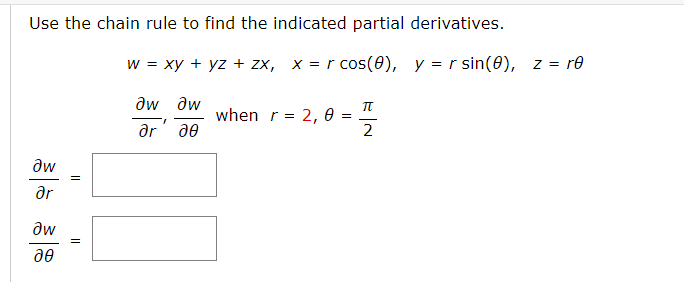Home /
Expert Answers /
Calculus /
use-the-chain-rule-to-find-the-indicated-partial-derivatives-p-sqrt-u-2-v-2-w-2-quad-pa420
(Solved): Use the chain rule to find the indicated partial derivatives. \[ P=\sqrt{u^{2}+v^{2}+w^{2}}, \quad ...
Use the chain rule to find the indicated partial derivatives. \[ P=\sqrt{u^{2}+v^{2}+w^{2}}, \quad u=x e^{y}, \quad v=y e^{x}, \quad w=e^{x y} \] \( \frac{\partial P}{\partial x}, \frac{\partial P}{\partial y} \) when \( x=0, y=6 \) \[ \begin{array}{l} \frac{\partial P}{\partial x}= \\ \frac{\partial P}{\partial y}= \end{array} \]
Use the chain rule to find the indicated partial derivatives. \[ w=x y+y z+z x, \quad x=r \cos (\theta), \quad y=r \sin (\theta), \quad z=r \theta \] \( \frac{\partial w}{\partial r}, \frac{\partial w}{\partial \theta} \) when \( r=2, \theta=\frac{\pi}{2} \) \[ \frac{\partial w}{\partial r}= \] \[ \frac{\partial w}{\partial \theta}= \]
Expert Answer
Given p=u2+v2+w2 where u=xey,v=yex,w=exy Applying partial derivative with respect to x , we have dpdx=ddx((xey)2+(yex)2+(exy)2) applying chain rule we

